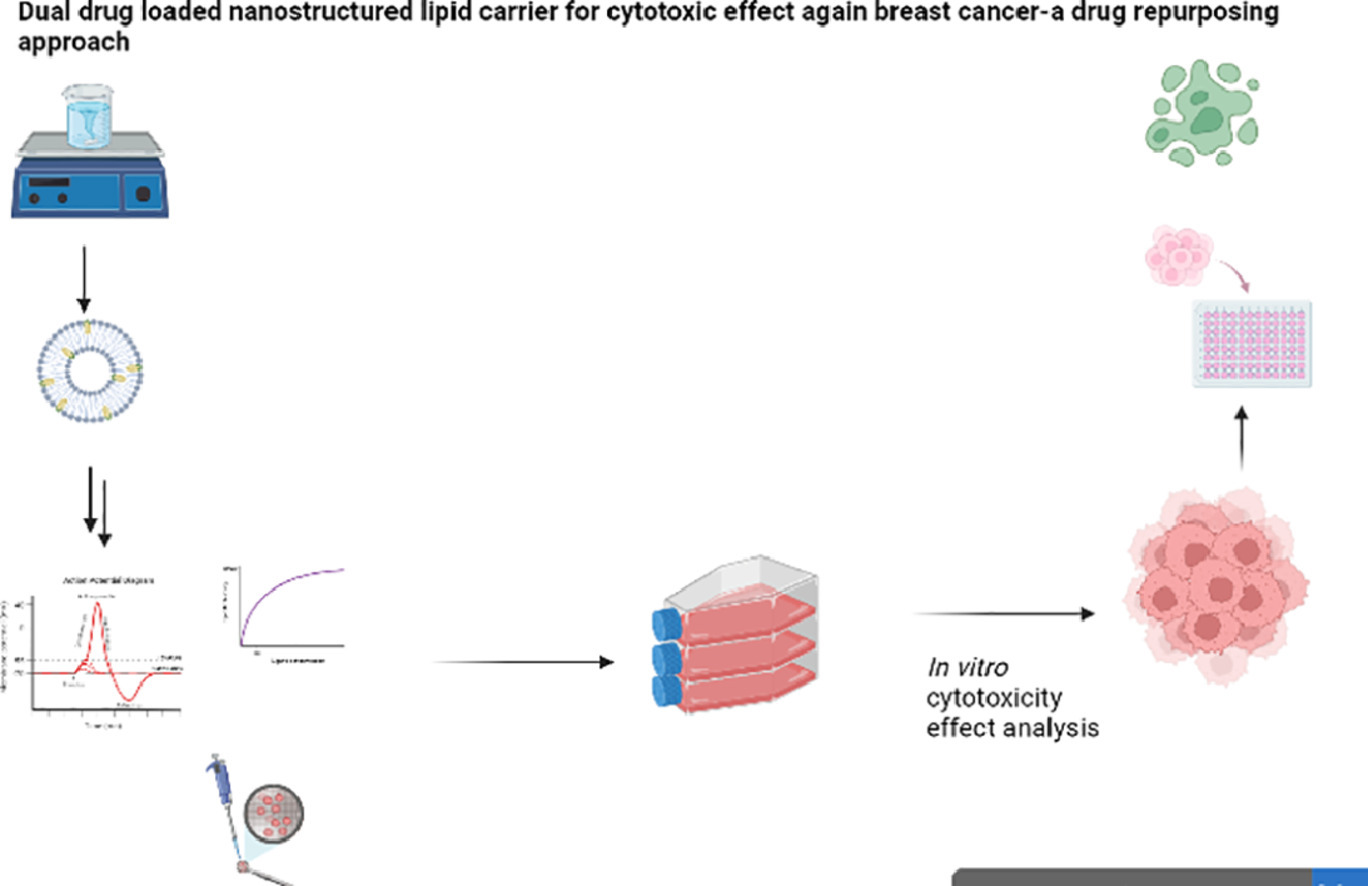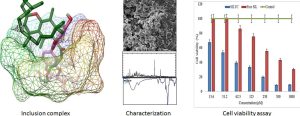Dual drug loaded nanostructured lipid carrier for cytotoxic effect against breast cancer-a drug repurposing approach.

Abstract
In the present study nanostructured lipid carrier with a combination of Metformin (MET) and Thymoquinone (THY) was developed, characterized, and was further evaluated for cytotoxic effect on breast cancer cells. The optimized MET-THY-NLCs were found with the size 78.99 nm with entrapment efficiency of 90.14±1.25% for MET and 91.63±2.05% for THY. Evaluation of the dual drug-loaded NLCs on breast cancer cells showed the enhanced cytotoxicity effect. In vitro analysis of the formulation showed an increase in cell apoptosis and cell cycle arrest was observed in breast cancer cells. Cellular internalization of the formulated drug was analyzed on a quantitative as well as qualitative basis by flow cytometry which shows enhanced uptake of the drug in the cells.
Introduction
Nanotechnology can be used to enhance cancer treatments through the delivery of drugs to the target site effectively. A nanostructured lipid carrier (NLC) is a type of drug delivery system that is composed of solid and liquid lipids and is capable of encapsulating both hydrophobic and hydrophilic drugs [1]. NLCs offer several advantages from the point of delivery of drugs over their predecessor solid lipid nanoparticles (SLN). SLNs are composed of solid fats which are dispersed in the aqueous phase with the help of emulsifiers. Low encapsulation rates, long-term stability issues, and leaking out of drugs from the crystalline structures are some of the drawbacks that scientists have faced during the development of SLNs [2]. However, the next generation of delivery systems in the form of NLCs has the potential to overcome these challenges.
Mixing of liquid lipids with solid lipids makes the otherwise perfect crystalline structure of solid lipids disorderly and this leads to higher drug loading and prevents drug leakage also [3]. Compared to other nano-carriers, NLCs are reported to be more stable, biocompatible, and have greater surface areas. Moreover, NLCs enhance the intracellular uptake of several anticancer agents, extend the release of the therapeutic agent, and therefore improve the pharmacokinetic parameters of drugs [4]. For effective cancer therapy, NLCs provide benefits from the improved permeability and retention effect, which is frequently seen in solid tumors, through passive targeting (also known as the EPR effect). The increased build-up of NLCs and drug-encapsulated particles occurs within the tumor tissue as a result of the leaky vasculature and inadequate lymphatic drainage of tumors. This passive targeting method minimizes off-target effects while enabling selective medication delivery and increased drug concentrations at the tumor location [5].
Breast cancer remains a major public health challenge and a high mortality rate and a high number of newly diagnosed cases of breast cancer are reported making it the most common cancer type among females. Multidisciplinary treatment is required for breast cancer [6,7]. The success of treatment depends heavily on preventing metastasis [8,9].
Moreover, the development of drug resistance is increasingly being reported. This makes it of the utmost importance to have efficient therapies for the treatment of cancer. One such method, where two or more drugs are administered simultaneously to have a synergistic effect, is popularly known as Combination Therapy. Treating cancer with combination therapy has been a subject of interest among researchers and has shown promising results in the past. The optimum synergistic ratio can significantly increase the therapeutic efficacy of a valid pharmaceutical combination. Combination therapy, which uses complementary and synergistic molecular processes, reduces the therapeutic dose needed for treatment, minimizes side effects, and minimizes the development of drug resistance while simultaneously improving drug efficacy [10]. In addition, drug synergism can help overcome drug resistance by making it more difficult for cancer cells to develop resistance. Also, if a cancer cell develops a particular target mutation as a result of treatment with one drug, a separate drug in the combination may target a different pathway, making it more challenging for the cancer cell to dodge treatment [11]. Despite the results, there are some challenges associated with it as well, such as extremely high costs of experimentation, time-consuming process, and relatively low probability of success [12,13].
Repurposing of drugs that are exploring new clinical indications of already existing drugs is a lucrative model for creating a new pipeline of drugs [14].
MCF-7 is the highly employed breast cancer cell line in research due to its high ER expression and therefore high hormone sensitivity. Other breast cancer cells triple-negative subtypes ER-, PR- and HER2-. MDA-MB-231 is one of the Claudin Low breasts cancer subtypes [15].
One of the bioactive from the biguanide family, Metformin (MET), is the most prescribed antihyperglycemic agent for type 2 diabetes. The hypoglycaemic action of MET is primarily associated with inhibiting hepatic gluconeogenesis and improving glucose uptake in the skeletal muscles [16]. Several studies have reported the antiproliferative effects, antiangiogenic effects, and antitumor actions of MET against cancer in recent years [17]. By inhibiting mTOR signaling by activating the AMPK pathway, MET inhibited tumor cell growth and proliferation in different cancers [18]. However, MET exhibits high water solubility (1.3 mg/mL) with less cell permeability, thus, it has low bioavailability around 40-60% [19].
Thymoquinone (THY) is one of the bioactive compounds of Nigella sativa (also known as black seed or habbatus sauda) seeds having major of biological anti-cancer activity [20]. Anticancer activity of thymoquinone is reported against several cancer cell lines including human cervical adenocarcinoma (HeLa) [21], human squamous carcinoma (SiHa) [22], human estrogen receptor-negative breast adenocarcinoma (MDA-MB- 231), and human estrogen receptor-positive breast adenocarcinoma (MCF-7) [23,24]. Various studies revealed that thymoquinone exhibits anticancer activity by interfering with P13/Akt signaling and upregulation of p 53 [23]. However, the use of thymoquinone is limited by its solubility related to poor oral bioavailability [24].
The present work aims to develop and characterize a carrier system in the form of nanostructured lipid carrier coloaded with metformin and thymoquinone further to carry out in vitro investigation of the prepared MET-THY NLCs. The prepared MET-THY NLC was subjected to size, morphological and spectroscopical characterizations. The optimized MET-Thy-NLCs were assessed by in vitro release studies in PBS with pH 7.4 and cellular uptake studies. Anticancer cytotoxicity effect was studied against breast cancer through MTT assay, cell migration, and cell cycle arrest.
Read more here
Materials
Metformin was a generous gift from Jubilant Generics Ltd, thymoquinone was obtained from Sigma Aldrich. Solid lipids Glycerol Monostea rate, Emulcire 61WL, Labrafil M 2130 CS, Precirol ATO 5, Gelucire 39/01, Compritol 888 ATO, Apifil..Liquid lipids castor oil, olive oil, linseed oil,captex GTO, almond oil and surfactant tween 20, labrasol, cremophore EL were purchased from Gattefosse India Pvt. Ltd (Mumbai, India). DAPI was obtained from Hi Media Pvt. Ltd.
Pallavi Kumari, Shweta Dang, Dual drug loaded nanostructured lipid carrier for cytotoxic effect against breast cancer-a drug repurposing approach., Surfaces and Interfaces, 2023, 103138, ISSN 2468-0230, https://doi.org/10.1016/j.surfin.2023.103138.
Read more on “Breast Cancer” here:


